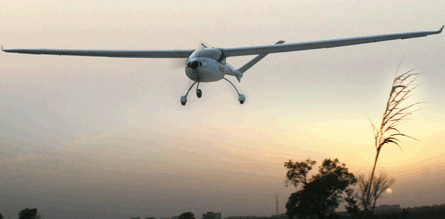All-electric light sport aircraft look set to lead the greening of general aviation in the USA as battery-powered products vie for sales by 2011, while alternate hydrocarbon fuels creep forward with no champion product.
Previous Experimental Aircraft Association AirVenture air shows in Oshkosh have included announcements of all-electric aircraft in development, but this year's saw the first light sport aircraft (LSA) product powered by batteries, the Yuneec E430. It was to make a demonstration flight at Oshkosh by 1 August and will be on sale from late 2010.
Using lithium polymer (li-poly) battery packs, the E430 is manufactured by the Shanghai based-Yuneec. It is now outfitting with production machinery a 24,155m2 (260,000ft2) facility it has built for the manufacture of electric aircraft. Shipment of the E430 is scheduled from late 2010 or early 2011.
Test flights are planned for 2010 and the E430 is said to fly for up to 2h with three li-poly battery packs and two people in an "optimum cruise". With its 40kW engine, the number of battery packs can be increased to five, providing for 3h of flight with just the pilot.
 |
|---|
© Yuneec |
"Remote control aircraft are now 80% electric. The number of electric remote control aircraft quadrupled in a few years after the technology became available. We saw the same opportunity in light aircraft," says Yuneec managing director sales and marketing worldwide Clive Coote.
He adds that Yuneec's development of the E430 and the Shanghai factory has been funded by the "independently wealthy" chairman of the company, Tian Yu. Started 2.5 years ago, Yuneec built its proof-of-concept aircraft in four months at the beginning of this year with 20 engineers working "around the clock". After a 30min test flight in Shanghai, the aircraft was shipped to the USA, where it undertook 22h of flying in Camarillo, California to be awarded its experimental certificate.
The development of the E430 follows the April 2008 EAA announcement at the CAFE Foundation 2008 Electric Aircraft Symposium that it had requested to the US Federal Aviation Administration for regulatory exemptions to allow electric motors in ultralights and LSAs.
That same year at Oshkosh local company Sonex unveiled its electric Waiex concept aircraft and in March 2008 Boeing flew its Dimona motorglider powered by batteries and fuel cells.
After a year of development work, Sonex unveiled a changed design at Oshkosh 2009 that, like the E430, uses li-poly batteries. Less confident about setting a date for a saleable product, Sonex demonstrated its electric engine for its planned product, the Electric Sports Aircraft. This would be a two-seater with a 10.9m (36ft) wingspan. The motor will deliver 55kW.
The company expects 4-10h of charging to give a 1h flight. The aircraft's battery pack has a 110kg (200lb) mass and a power density of 14,000kW/h. Sonex chief executive Jeremy Monnett says: "We have one [li-poly] battery pack as we want to keep it simple and compact."
He adds that the company wants an electric engine that has a volume that can fit into existing aircraft to enable a retrofit market.
However, Oshkosh also saw the unveiling of a hybrid engine. Stuttgart, Germany-based Flight Design's Hybrid Power Engine uses a 30kW permanent magnet synchronous motor in combination with a Rotax 914 engine, the development for which began three years ago. The purpose of the battery and electric motor is to provide boost power to enable take-off.
The Hybrid Power Engine uses technology from the automotive sector, such as its electric motor controller electronics. Flight Design uses lithium ion batteries instead of li-poly. Like Sonex, Flight Design has built a proof-of-concept engine and ground test runs are being continued.
In the second half of this year the Stuttgart company expects to carry out flight tests. "It looks, so far, super promising," says Christian Wenger, Flight Design's chief procurement officer.
Also holding promise are unleaded gasoline type alternate fuels for general aviation. Unleaded fuel is the subject of ongoing work by the General Aviation Manufacturers Association.
A meeting was held at Oshkosh to discuss the unleaded fuels issue and the industry's representatives are working towards a standard, which may be one of four different unleaded fuels, 91, 93 or 94 - the number denoting the octane level.
One engine manufacturers' engineering vice-president says that 94 is the likely choice as it more closely resembles the existing gasoline used by general aviation aircraft - 101 low lead fuel - once its lead is "removed" at the refinery.
While GAMA continues to work to advance the introduction of unleaded fuels and Sonex and Flight Design build to first flights, Yuneec is already thinking about its next product, which it wants to demonstrate at Oshkosh next year - a solar cell augmented electric propulsion system for extending flight times.
Source: Flight International























